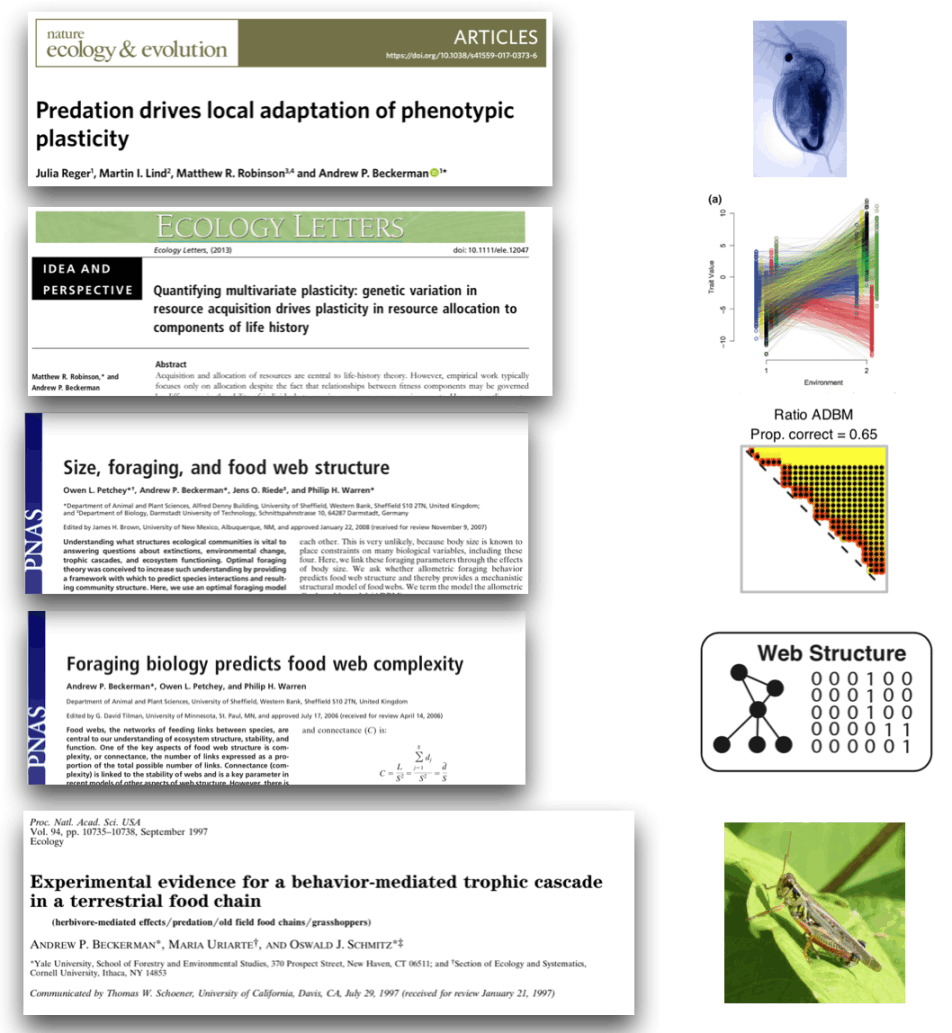Food Webs -- We work on food web biology. We connect foraging biology and species interactions to explore the dynamics of species and the stability, structure and function of ecological communities.
-- We provided the first mechanistic explanation of what determines the connectance (the number of interactions) and structure of a food web.
-- We explore how optimal foraging and other traits underpin predictions about the dynamics and stability of communities facing multiple simulataneous threats.
-- We develop models to explore the dynamics of populations, communities/biodiversity and ecosystem function.
Key Food Web Papers
Clegg, T., Ali, M. and Beckerman, A.P. 2018 The impact of intraspecific variation on food web structure. Ecology 99:2712-2720
Thierry, A., O. L. Petchey, A. P. Beckerman, P. H. Warren, and R. J. Williams. (2011). The consequences of size dependent foraging for food web topology. Oikos 120:493-502.
Thierry, A., A. P. Beckerman, P. H. Warren, R. J. Williams, A. J. Cole, and O. L. Petchey. (2011). Adaptive foraging and the rewiring of size-structured food webs following extinctions. Basic and Applied Ecology 12:562-570.
Petchey, O. L., A. P. Beckerman, J. O. Riede, and P. H. Warren. (2008). Size, foraging, and food web structure. Proceedings of the National Academy of Sciences 105:4191-4196.
Beckerman, A. P., O. L. Petchey, and P. J. Morin. (2010). Adaptive foragers and community ecology: linking individuals to communities and ecosystems. Functional Ecology 24:1-6.
Beckerman, A. P., O. L. Petchey, and P. H. Warren. (2006). Foraging biology predicts food web complexity. Proceedings of the National Academy of Sciences of the United States of America 103:13745-13749.
Ecology, Evolution & Phenotypic Plasticity -- We work on predator-prey interactions and predator induced phenotypic plasticity. We use Daphnia pulex, several rotifer species and several algae species and their morphological defences as a model organism.
-- We examine the genetic, genomic and endocrine basis of predator induced phenotypic plasticity.
-- we have advanced our understanding of how to evaluate genetic and phenotypic trade-offs and detect local adaptation of traits and of plasticity in these traits.
-- we developed statistical tools to analyse the ecology and evolution of multivariate phenotypic plasticity.
-- We use our ideas to develop sustainable, ecology inspired solutions to engineering problems, including mitigation of eutrophication and production of low and high value algae based products.
Key Daphnia Papers
Reger, J. Lind, MI, Robinson*, M. Beckerman*, AP 2018 Predation drives local adaptation of phenotypic plasticity Nature Ecology & Evolution 2: 100–107 [*equal contribution] https://doi.org/10.1038/s41559-017-0373-6
Carter, MJ, Lind, MI, Hentley, W. Dennis, SR, Beckerman, AP 2017 Evolution of a predator-induced, non-linear reaction norm Proceedings of the Royal Society 284 20170859 DOI: 10.1098/rspb.2017.0859
Lind, M. I., K. Yarlett, J. Reger, M. J. Carter, and A. P. Beckerman. 2015. The alignment between phenotypic plasticity, the major axis of genetic variation and the response to selection. Proceedings of the Royal Society 282: 20151651. http://dx.doi.org/10.1098/rspb.2015.1651
Robinson, M. R., and A. P. Beckerman. 2013. Quantifying multivariate plasticity: genetic variation in resource acquisition drives plasticity in resource allocation to components of life history. Ecology Letters:281-290.
Dennis, S. D., G. A. LeBlanc, and A. P. Beckerman. 2014. Endocrine regulation of predator-induced phenotypic plasticity. Oecologia 176:625–635.
Key Algae Papers
Sebastiana Roccuzzo, Narciso Couto, Esther Karunakaran, Rahul Vijay Kapoore, Thomas O Butler, Joy Mukherjee, Erika M Hansson, Andrew P Beckerman, Jagroop Pandhal 2020. Metabolic Insights Into Infochemicals Induced Colony Formation and Flocculation in Scenedesmus subspicatus Unraveled by Quantitative Proteomics Frontiers in Microbiology 11:792
Russo, D., Beckerman, A.P., Pandhal. J. 2017 Competitive growth experiments with a high-lipid Chlamydomonas reinhardtii mutant strain and its wild-type to predict industrial and ecological risks. AMB Express (Applied and Industrial Biotechnology) 7:10 DOI: 10.1186/s13568-016-0305-x
Roccuzzo, S., Beckerman, A.P. and Pandhal, J. 2016. The use of natural infochemicals for sustainable and efficient harvesting of microalgae for biotechnology: insights from a meta-analysis. Biotechnology Letters 38(12): 1983–1990 doi: 10.1007/s10529-016-2192-2
Russo, D. Beckerman, AP, Couto, N., Pandhal,J. 2016. A metaproteomic analysis of the response of a freshwater microbial community under nutrient enrichment. Frontiers in Microbiology 7 1172 (doi: 10.3389/fmicb.2016.01172
Parrots and Conservation Biology-- We work on parrots, linking their demography to socioeconomic constraints and trade-offs that influence their management as endangered species.
We have long term collaborations with the World Parrot Trust centred on biological and social science research into what makes parrot conservation work. We work in Bonaire on Yellow Shouldered Amazons, in Costa Rica on McCaws and theoretically on the demography and economics of parrots.
Key Conservation Papers
James, TD, Salgero-Gomez, R., Jones, OR, Childs, DZ, Beckerman, AP. 2020. Bridging gaps in demographic analysis with phylogenetic imputation. Conservation Biology https://doi.org/10.1111/cobi.13658
Roberts M.H., Martin R.O., Beckerman A.P. & Williams S.R. 2014. Occupation rates of artificial and restored natural nest cavities by yellow-shouldered Amazons Amazona barbadensis on Bonaire, Caribbean Netherlands. Conservation Evidence, 11, 39-42.
Beckerman, A. P., M. Boots, and K. J. Gaston. (2007). Urban bird declines and the fear of cats. Animal Conservation 10:320-325.
Graham, K., A. P. Beckerman, and S. Thirgood. (2005). Human-predator-prey conflicts: ecological correlates, prey losses and patterns of management. Biological Conservation 122:159-171.
